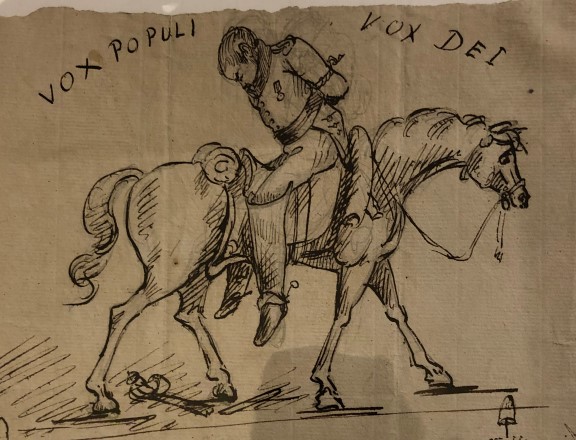Newly discovered George Cruikshank political cartoon evokes historic parallels between political violence 200 years ago and now
- Tuesday, September 22, 2020
A recently unearthed caricature by the famous illustrator George Cruikshank shows that state violence against political demonstrations is nothing new.

The cartoon was a response to the shooting dead by troops of two unarmed supporters of Queen Caroline, the estranged wife of king George IV. The incident was the tragic culmination of an extraordinary year of popular protest which began in the summer of 1820 when Caroline was prevented from becoming queen of England and put on trial for adultery. The British people rallied to her cause in their hundreds of thousands, seizing the opportunity to attack an unpopular Tory government who had recently presided over the Peterloo massacre and draconian restrictions on free speech. Caroline’s trial was a media sensation and a field-day for caricaturists. Political cartoons exposed the injustice and double standards of the queen’s treatment by a king who was renowned for promiscuity. His refusal to allow Caroline to attend his lavish coronation in July 1821 may have hastened her death a few weeks later. The end of her story was as contentious as the beginning: a dispute over the route of her funeral procession led to troops firing on the crowd in Hyde Park. Two men, Richard Honey and George Francis, were killed. No one was prosecuted for the killings.
The unpublished cartoon, which was discovered in New York Public Library by Professor Ian Haywood of Roehampton university, imagines the punishment of the officer in charge of the troops. Instead of a legal trial, the officer is forced to parade backwards on a horse. This was a traditional method of community shaming known as charivari, and it implies that the ‘vox populi’ or voice of the people has finally been heard.
‘The discovery of this image shows the unique power and imaginative freedom of political caricature,’ says Haywood. ‘The cartoon is a statement that ordinary lives matter. I am delighted to bring it back into circulation’.
Find out more about studying Humanities at Roehampton